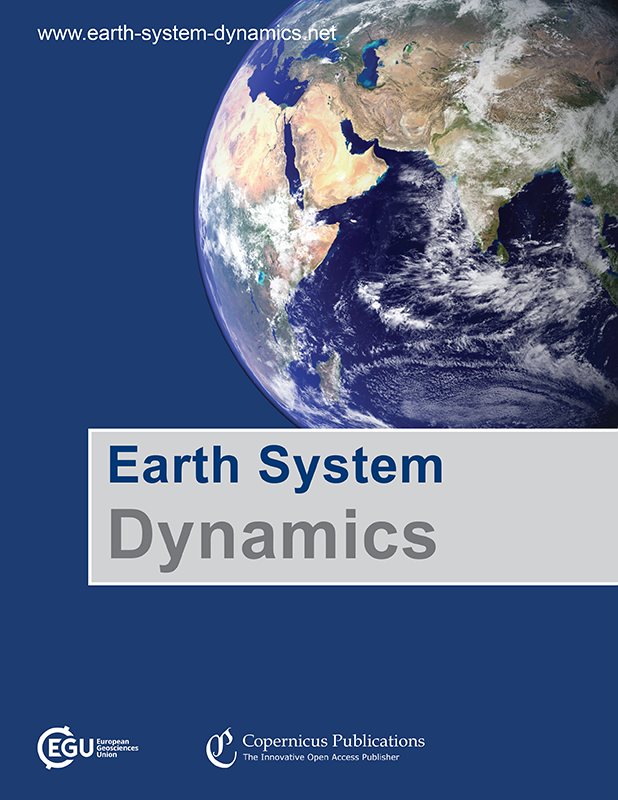Scenario choice impacts carbon allocation projection at global warming levels
IF 7.2
2区 地球科学
Q1 GEOSCIENCES, MULTIDISCIPLINARY
引用次数: 0
Abstract
Abstract. We show that the distribution of anthropogenic carbon between the atmosphere, land surface, and ocean differs with the choice of projection scenario even for identical changes in mean global surface temperature. Warming thresholds occur later in lower-CO2-emissions scenarios and with less carbon in the three main reservoirs than in higher-CO2-emissions scenarios. At 2 ∘C of warming, the mean carbon allocation differs by up to 63 PgC between scenarios, which is equivalent to approximately 6 years of the current global total emissions. At the same warming level, higher-CO2-concentration scenarios have a lower combined ocean and land carbon allocation fraction of the total carbon compared to lower-CO2-concentration scenarios. The warming response to CO2, quantified as the equilibrium climate sensitivity, ECS, directly impacts the global warming level exceedance year and hence the carbon allocation. Low-ECS models have more carbon than high-ECS models at a given warming level because the warming threshold occurs later, allowing more emissions to accumulate. These results are important for carbon budgets and mitigation strategies as they impact how much carbon the ocean and land surface could absorb at a given warming level. Carbon budgeting will be key to reducing the impacts of anthropogenic climate change, and these findings could have critical consequences for policies aimed at reaching net zero.情景选择影响全球变暖水平下的碳分配预测
摘要我们的研究表明,即使在全球平均表面温度变化相同的情况下,人为碳在大气、陆地表面和海洋之间的分布也会随着预测情景的选择而不同。与二氧化碳排放量较高的情景相比,二氧化碳排放量较低的情景出现变暖阈值的时间较晚,且三个主要碳库中的碳含量较少。在升温 2 ∘C 的情况下,不同情景下的平均碳分配差异高达 63 PgC,相当于目前全球总排放量的大约 6 年。在相同的变暖水平下,与二氧化碳浓度较低的情景相比,二氧化碳浓度较高的情景的海洋和陆地碳分配在总碳分配中所占的比例较低。对二氧化碳的升温响应,量化为平衡气候敏感度(ECS),直接影响全球变暖水平超标年,从而影响碳分配。在给定的升温水平下,低 ECS 模型比高 ECS 模型有更多的碳,因为升温临界点出现得更晚,使得更多的排放得以累积。这些结果对碳预算和减排战略非常重要,因为它们会影响海洋和陆地表面在特定升温水平下可吸收的碳量。碳预算将是减少人为气候变化影响的关键,这些发现可能会对旨在实现净零排放的政策产生至关重要的影响。
本文章由计算机程序翻译,如有差异,请以英文原文为准。
求助全文
约1分钟内获得全文
求助全文
来源期刊

Earth System Dynamics
GEOSCIENCES, MULTIDISCIPLINARY-
CiteScore
13.20
自引率
5.50%
发文量
61
审稿时长
36 weeks
期刊介绍:
Earth System Dynamics (ESD) is a not-for-profit international scientific journal committed to publishing and facilitating public discussion on interdisciplinary studies focusing on the Earth system and global change. The journal explores the intricate interactions among Earth's component systems, including the atmosphere, cryosphere, hydrosphere, oceans, pedosphere, lithosphere, and the influence of life and human activity. ESD welcomes contributions that delve into these interactions, their conceptualization, modeling, quantification, predictions of global change impacts, and their implications for Earth's habitability, humanity, and the future dynamics in the Anthropocene.
 求助内容:
求助内容: 应助结果提醒方式:
应助结果提醒方式:


